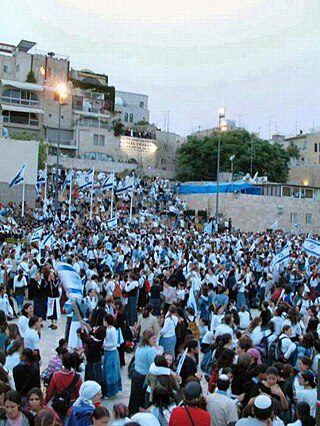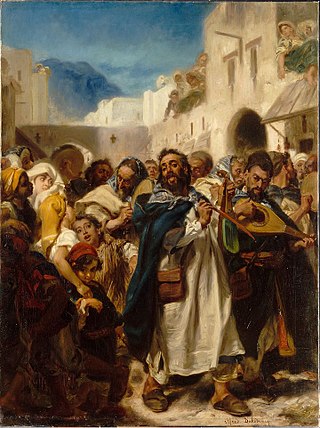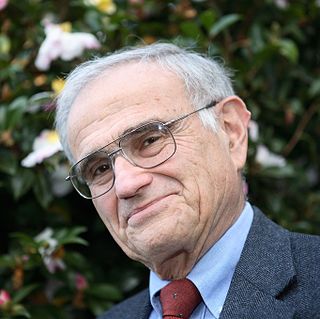
Max Simon Nordau was a Zionist leader, physician, author, and social critic.

The Star of David is a generally recognized symbol of both Jewish identity and Judaism. Its shape is that of a hexagram: the compound of two equilateral triangles.

The Haskalah, often termed the Jewish Enlightenment, was an intellectual movement among the Jews of Central and Eastern Europe, with a certain influence on those in Western Europe and the Muslim world. It arose as a defined ideological worldview during the 1770s, and its last stage ended around 1881, with the rise of Jewish nationalism.

Religious Zionism is a religious denomination that views Zionism as a fundamental component of Orthodox Judaism. Its adherents are also referred to as Dati Leumi, and in Israel, they are most commonly known by the plural form of the first part of that term: Datiim. The community is sometimes called 'Knitted kippah', the typical head covering worn by male adherents to Religious Zionism.

Jewish emancipation was the process in various nations in Europe of eliminating Jewish disabilities, e.g. Jewish quotas, to which European Jews were then subject, and the recognition of Jews as entitled to equality and citizenship rights. It included efforts within the community to integrate into their societies as citizens. It occurred gradually between the late 18th century and the early 20th century.

Jewish culture is the culture of the Jewish people, from its formation in ancient times until the current age. Judaism itself is not simply a faith-based religion, but an orthoprax and ethnoreligion, pertaining to deed, practice, and identity. Jewish culture covers many aspects, including religion and worldviews, literature, media, and cinema, art and architecture, cuisine and traditional dress, attitudes to gender, marriage, family, social customs and lifestyles, music and dance. Some elements of Jewish culture come from within Judaism, others from the interaction of Jews with host populations, and others still from the inner social and cultural dynamics of the community. Before the 18th century, religion dominated virtually all aspects of Jewish life, and infused culture. Since the advent of secularization, wholly secular Jewish culture emerged likewise.

Hebrew literature consists of ancient, medieval, and modern writings in the Hebrew language. It is one of the primary forms of Jewish literature, though there have been cases of literature written in Hebrew by non-Jews. Hebrew literature was produced in many different parts of the world throughout the medieval and modern eras, while contemporary Hebrew literature is largely Israeli literature. In 1966, Agnon won the Nobel Prize for Literature for novels and short stories that employ a unique blend of biblical, Talmudic and modern Hebrew, making him the first Hebrew writer to receive this award.
The International Jewish Sports Hall of Fame was opened July 7, 1981, in Netanya, Israel. It honors Jewish athletes and their accomplishments from anywhere around the world.
The Jewish question was a wide-ranging debate in 19th- and 20th-century Europe that pertained to the appropriate status and treatment of Jews. The debate, which was similar to other "national questions", dealt with the civil, legal, national, and political status of Jews as a minority within society, particularly in Europe during the 18th, 19th, and 20th centuries.

SC Hakoah Vienna is a Jewish sports club in Vienna, Austria.

Racial antisemitism is prejudice against Jews based on a belief or assertion that Jews constitute a distinct race that has inherent traits or characteristics that appear in some way abhorrent or inherently inferior or otherwise different from the traits or characteristics of the rest of a society. The abhorrence may find expression in the form of discrimination, stereotypes or caricatures. Racial antisemitism may present Jews, as a group, as a threat in some way to the values or safety of a society. Racial antisemitism can seem deeper-rooted than religious antisemitism, because for religious antisemites conversion of Jews remains an option and once converted the "Jew" is gone. In the context of racial antisemitism Jews cannot get rid of their Jewishness.
Maccabi World Union is an international Jewish sports organisation spanning five continents and more than 50 countries, with some 400,000 members. The Maccabi World Union organises the Maccabiah Games, a prominent international Jewish athletics event.

How Soccer Explains the World: An Unlikely Theory of Globalization is a book written by American journalist Franklin Foer. It is an analysis of the interchange between soccer and the new global economy.
"Negation of the Diaspora" is a concept in Zionism that asserts that the Diaspora—that is, all Jews dispersed outside of the Land of Israel—is a state of being that inherently causes Jewish assimilation, particularly through discrimination and persecution, and thereby must be repudiated to ensure the survival and the cohesion of the Jews as a people. A more developed formulation of the idea further argues that the Jewish people have no future without amassing at their "spiritual centre" in the Land of Israel, which is currently represented by the State of Israel.

Morgnshtern was a Jewish sports organisation in interbellum Poland, politically linked to the Bund. It was founded in the end of 1926. Morgnshtern increased significantly in influence in the period just preceding the Second World War. In 1937 the organisation had 107 local branches in different parts of the country. Its largest branch was based in Warsaw. In 1936, the Warsaw branch had 956 active members, in 1937 he membership reached around 1500 and 1855 in 1938.
Edward Lawrence Levy was a British weightlifter.
Frédéric Brenner is a French photographer known for his documentation of Jewish communities around the world. His work has been exhibited internationally, among others, at the International Center of Photography in New York, the Musée de l'Élysée in Lausanne, Rencontres d'Arles in Arles, the Brooklyn Museum in New York, and the Joods Historisch Museum in Amsterdam.
During the 20th century, specifically in the Interwar period, athletics became a point of social integration in Jewish communities throughout Europe. Specifically within German society, playing sports provided a chance for Jews to gain social standing and even notoriety for their accomplishments. Additionally, cheering for local area sports teams and clubs provided a common (secular) point of interest between Jews and non-Jews. While there are many instances of social integration and acceptance as a result of sports, antisemitism was common at sporting events in central Europe as well. Discrimination, provocation, and riots occurred at sporting events and in response to Jewish athletes, coaches, and managers. As such, the public perception of Jewish athletics was mixed, with notable examples of fame and antisemitism throughout the 20th century.

Michael Albert Meyer is a German-born American historian of modern Jewish history. He taught for over 50 years at the Hebrew Union College-Jewish Institute of Religion in Cincinnati, Ohio. He is currently the Adolph S. Ochs Emeritus Professor of Jewish History at that institution. He was one of the founders of the Association for Jewish Studies, and served as its president from 1978–80. He also served as International President of the Leo Baeck Institute from 1992–2013. He has published many books and articles, most notably on the history of German Jews, the origins and history of the Reform movement in Judaism, and Jewish people and faith confronting modernity. He is a three-time National Jewish Book Award winner.
Max Scheuer was an Austrian international footballer who played the defender position. He played for the Austria national football team in the 1923 season. In the 1920s, he played for and captained Hakoah Vienna. He was murdered in the Auschwitz concentration camp at some point after August 1941.














